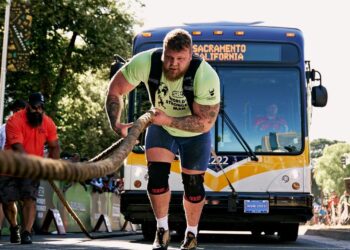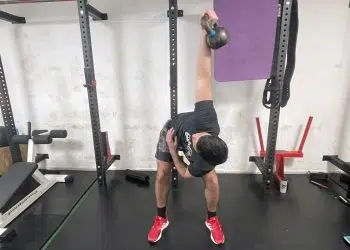Close your eyes and imagine what the strongest guy in the world would ideally look like. Chances are, you pictured an individual with hulking arms who could bend steel rods with his bare hands.
Big arms have long been one of the most common strongman characteristics across cinema, comics, and sculpture. Apart from all the strength benefits, there is no denying the fact that a pair of chiseled guns look sick.
However, even after all the bicep fanfare, only a few people ever manage to build sleeve-ripping pythons. One of the most common reasons behind lagging arm development is a lack of variety in training.
We use different kinds of exercises to develop a muscle group — rowing and pulling for the back, pressing and lateral raise for the shoulders, squatting and leg extension for the quads, presses and fly for the chest, and crunching and twisting for the abdominal.
On the other hand, when it comes to training arms, curls are all we have got. Do not get us wrong. Bicep curls are incredibly effective for building your biceps.
However, you need to use advanced training techniques to ensure you are not leaving gains on the table — which brings us to the static bicep curl.
Level Up Your Fitness: Join our 💪 strong community in Fitness Volt Newsletter. Get daily inspiration, expert-backed workouts, nutrition tips, the latest in strength sports, and the support you need to reach your goals. Subscribe for free!
Muscles Worked
The static bicep curl is one of those exercises that look super easy but can kill you by the time you are done with them. It is a form of isometric training that can help you bust out your bicep veins.
Unlike a curl, an isometric hold involves keeping your muscle flexed and contracted for an extended period.
The static bicep curl primarily works the short bicep head and helps improve your bicep peak. A few variations of the static bicep curl can also target the brachialis and brachioradialis — which can add thickness to your arms.
How To Static Bicep Curl
Here is how to perform the static bicep curl:
- Set an incline bench at a 70-degree angle with the floor.
- Grab a dumbbell with a supinated grip and place the back of your upper arm flat against the incline of the bench.
- Your shoulder and elbow should be in a straight line throughout the lift.
- Slowly extend your arm until the dumbbell is touching the bench. This will be your starting position.
- With a controlled motion, curl the dumbbell until your forearm is perpendicular to the incline of the bench.
- Hold this position for 15-20 seconds and contract your bicep as hard as you can.
- Slowly return to the starting position.
- Repeat for the recommended reps before switching sides.
Tips
- Keep your upper arm glued to the bench throughout the movement.
- If your upper arm is coming off the bench while curling the dumbbell, you should use a lighter dumbbell.
- Keep your wrist locked. Make sure you are not flexing it while lifting the dumbbell.
- Placing your other hand on top of the bench can add stability to the lift.
- Using a staggered stance can aid in putting more focus on your bicep.
- If you can hold the weight for longer than 20 seconds, you should use a heavier dumbbell.
Benefits and Drawbacks
Before you add an exercise to your training regimen, you should know the ins and outs of the lift. Here is how the static bicep curl impacts your muscle mass and strength:
Benefits of Static Bicep Curl
1. Increased Muscle Strength
If your goal is to build muscle strength, you should focus on maximal muscle fiber recruitment — and it is exactly what the static bicep curl delivers.
Performing an isometric exercise usually results in a greater muscle fiber recruitment compared to standard concentric and eccentric lifts.
On top of this, performing the isometric exercise regularly can help build muscle memory which can carry over to conventional concentric and eccentric lifts — aiding in better muscle stimulation.
2. Improved Muscle Growth
The static bicep curl keeps constant tension on your target muscle throughout the exercise. It floods your muscles with blood and nutrients, helping you achieve hypertrophy.
While performing the static curl, you will experience nastier bicep pumps compared to the orthodox curl. Your pythons will be begging for mercy by the end of a set.
3. Better Mind-Muscle Connection
Most lifters cannot achieve a mind-muscle connection because they rush through an exercise. Going through the motions just for the sake of it won’t help you budge the needle.
The static bicep curl is an isolation exercise where you will be holding the contraction to the point where you can feel the deep muscle fibers contracting and firing. The longer time-under-tension (TuT) will invariably help you build a strong mind-muscle connection.
4. Requires Minimum Equipment
Most static bicep curl variations only require a pair of dumbbells — making it a great exercise that can be done at home.
It is also a great exercise for when you are traveling. Since the isometric exercise has a longer TuT, you don’t need a heavy set of dumbbells. Even the limited dumbbells at a hotel gym can get the job done.
Level Up Your Fitness: Join our 💪 strong community in Fitness Volt Newsletter. Get daily inspiration, expert-backed workouts, nutrition tips, the latest in strength sports, and the support you need to reach your goals. Subscribe for free!
5. Improves Muscle Endurance
While most resistance exercises focus on building muscular strength, the static bicep curl goes a step further and improves your muscle endurance.
But why is muscle endurance important, you ask?
According to a study, greater levels of muscular endurance are associated with a decreased risk of cardiovascular disease.
Muscle endurance adds to your functionality as many daily activities and sports require you to use your muscles repeatedly for an extended period. A combination of muscle strength and endurance can be a game-changer.
Drawbacks of Static Bicep Curl
Static exercises are great for beginners and advanced lifters alike. However, lifters suffering from bicep tendon issues can have problems due to the higher time under tension associated with the isometric bicep curl.
Static Bicep Curl Variations
The static bicep curl is an incredibly effective static isolation lift that deserves a place in your training routine.
Here are a few variations and alternatives of the exercise to add to your arsenal:
1. Dumbbell Bicep Curl with Static Hold
The dumbbell curl with static hold combines the conventional curling movement and static hold in a single exercise. You will need a couple of dumbbells for this lift.
Here is how to perform the dumbbell bicep curl with static hold:
- Stand upright with a shoulder-width stance.
- Grab a dumbbell in each hand with a supinated (palms facing up) grip.
- At the starting position, the dumbbells will be resting against your thighs.
- While keeping your elbows pinned to your sides, curl the left dumbbell until your left forearm is parallel to the floor.
- Maintaining that position, curl the dumbbell in the opposite arm for desired reps.
- Switch sides.
Tips
- Make sure you are actively contracting both biceps throughout the exercise.
- Your static lower arm should always be parallel to the floor. Do not lift it higher or let it hang lower as it will take off tension from the bicep.
- You could also perform this exercise using a hammer (palms facing each other) grip.
2. Reverse Dumbbell Bicep Curl with Static Hold
The reverse curl with static hold is a great exercise for building your long bicep head and brachioradialis. Since you will be using an overhand grip and extending your arm straight with every rep, you will be training your long bicep head (brachii) and forearm in this lift.
Here is how to perform reverse dumbbell bicep curl with static hold:
- Stand upright with a shoulder-wide stance.
- Grab a dumbbell in each hand with a pronated (palms facing down) grip.
- While keeping your elbows pinned to your sides, curl the left dumbbell until your left forearm is parallel to the floor.
- Maintaining that position, curl the dumbbell in the opposite arm for desired reps.
- Switch sides.
Tips
- You would want to use a lighter dumbbell for this exercise compared to what you used in the previous two variations.
- As fatigue starts to kick in, your static hand might start to pronate. Make sure both dumbbells are parallel to the floor throughout the exercise.
- If the weight feels too light, you could add to the difficulty by using a monkey (thumbs over the bar) grip. Doing this will result in greater forearm activation.
3. Barbell Curl Static Hold
In this variation, you will be using a barbell instead of the dumbbells. Establishing a mind-muscle connection can be a little harder in this exercise as you’ll be curling with both your arms at the same time.
How to perform barbell curl static hold:
- Stand upright with a shoulder-wide stance.
- Grab a cambered bar at shoulder-width with an underhand grip.
- With a slow and controlled motion, curl the bar until your forearms are parallel to the floor.
- Pause and contract your biceps at this position for 15-20 seconds.
- Slowly return to the starting position.
- Repeat for reps.
Tips
- Keep your elbows pinned to your sides throughout the exercise.
- You could also use dumbbells for this exercise.
- Performing the barbell curl static hold with an overhand grip will target your forearms and long bicep head.
4. Cable Curl Static Hold
Unlike free weights, a cable puts constant tension on your muscles throughout the exercise. Using a cable pulley instead of a barbell can turn up the heat for your bicep gains.
How to perform cable curl static hold:
- Attach a straight bar to a pulley machine adjusted at the lowest setting.
- Stand upright while holding the bar with a shoulder wide grip.
- While keeping your elbows pinned to your sides, curl the bar until your forearms are parallel to the floor.
- Pause at the top for 15-20 seconds.
- Slowly return to the starting position and repeat for reps.
Tips
- If you are on the move or training at home, you could use a resistance band for this exercise.
- Make sure you are not leaning back or bending forward while performing the lift.
- Perform lying cable curl static hold to better isolate your bicep peak.
- You could also use a couple of D-handles for the exercise — as shown in the video.
Static Bicep Curl Workout
Since the static curl is an isometric exercise, it is best performed at the end of a workout when your muscles are already exhausted. If you perform this exercise at the beginning of a workout, you will have to use a heavier weight — which can increase the chances of an injury.
The Arm Workout From Hell
- Barbell Bicep Curl: 3 sets of 12 reps, 60-second rest
- Incline Bench Dumbell Curl: 3 sets of 12 reps, 60-second rest
- Hammer Curl: 3 sets of 12 reps, 60-second rest
- Static Bicep Curl: 3 sets of 12 reps, 60-second rest
- High Cable Bicep Curl: 3 sets of 12 reps, 60-second rest
- Reverse Grip Cable Curl: 3 sets of 12 reps, 60-second rest
Next Read: Isotonic vs. Isometric Exercises – Differences, Benefits, and Examples
Wrapping Up
Since biceps are a relatively small muscle group, you do not need to train them more than once a week or use an insane amount of weight. You could turn your biceps into mountain peaks by employing advanced training techniques and hitting your guns from all angles.
The static bicep curl is a great way of exhausting your pythons without overwhelming them. Focus on establishing a strong mind-muscle connection, contracting the life out of your pythons with every rep, and you will be on your way to building your dream arms. Best of luck!
Interested in measuring your progress? Check out our strength standards for Barbell Curl, Incline Dumbbell Curl, Dumbbell Curl, and more.








